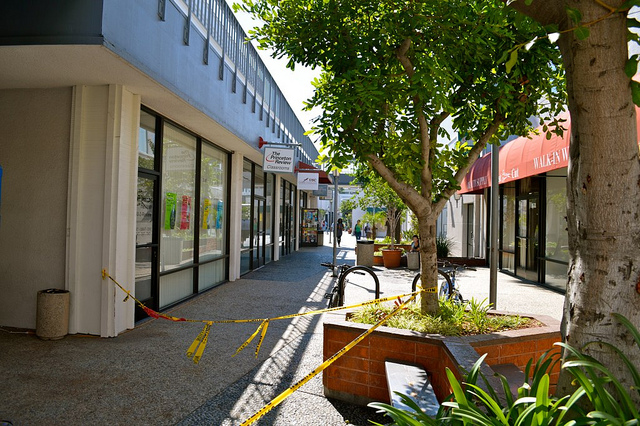Neighborhood Advocates Win $20 Million Fund To Soften USC Expansion's Impact

“There was a significant add to the cost,” said Kristina Raspe, vice president of real estate and asset management at USC. “We definitely went up a significant amount of money toward affordable housing.”
The plan that the university originally proposed for their 35-acre, $1.1 billion expansion project budgeted $2 million toward affordable housing, which Raspe said her department had considered to be enough since the plan will contribute to the community in other ways. For example, USC plans to construct a new fire station for the city of Los Angeles.
But activist groups, Strategic Actions for a Just Economy (SAJE) and United Neighbors in Defense Against Displacement (UNIDAD), objected to the smaller amount, saying it did not fully account for the project’s impact on the community. The groups worry the project will force small businesses and low-income residents out of the neighborhood.
City Council members Bernard Parks and Jan Perry proposed increasing the contribution to $20 million to address these concerns.
“You have to look at USC a little different,” Parks said in an interview, “with a billion-dollar project, $20 million is peanuts and maintaining affordable housing [in the area] is vital.”
Affordable housing is available to families that meet low-income requirements as determined by the Los Angeles Housing Department. 306 units of affordable housing across 16 locations fall into the 90007 ZIP code around USC, according to the 2011 Housing Department affordable housing roster. Only 63 of those units, in three locations are within the area affected by USC’s Master Plan and they are all in districts that the University does not plan to develop for at least 10 years. The first phase of the plan will only include construction on the main USC campus and in the University Village shopping and residential complexes, which stretch from Vermont Avenue to Hoover Street between Jefferson Boulevard and West 31st Street.
Even if the University’s proposed expansion does not call for the demolition of any housing in the neighborhood, some residents still feel pressured. Tenants of the 100-year-old apartment building on 29th and Flower Street, sent a letter to the city and held a demonstration on Nov. 8th. The 33-unit building is managed by a student housing group, but about half of its residents are low-income families. Some of those families say they have been offered money to move out, though they won’t say by whom. In their letter, they pleaded with the city not to overlook them as they become surrounded by multi-million dollar developments.
“There’s a lot of redevelopment of this area,” said Thelmy Perez, an organizer with the LA Human Right to Housing Collective. She helped organize the Flower St. apartment protest with groups LA CAN and Comunidad Presente. “You have the university to the south, you have the proposed Farmer’s Field development that’s just north of us, you have the giant Palmer project that’s up here on the corner, you have the new Icon project that’s over here on the corner of Figueroa and Jefferson and the Metro [Expo] rail line [across the street].”
Whether or not USC’s expansion displaces any residents, the neighborhood is changing quickly and organizers and residents worry that the construction of large housing and retail facilities will gentrify the neighborhood, increasing rent prices and driving poor families away.
In addition to increasing their contribution toward affordable housing tenfold, USC agreed to increase the number of beds for students in the Village plan to bring more students onto campus, freeing up housing in the neighborhood. The construction of the new University Village space will add 3,000 beds to campus housing—the original plan was for only 1,200 beds.
As for USC’s $20 million contribution, that will be handed over to the city to distribute. Raspe explained that with the new agreement, the USC Real Estate office will not be drawing up plans to build any new housing for the community in the way that they will for the fire station.
Other large-scale construction projects around Los Angeles contribute to the Los Angeles Housing Department affordable housing program as well, for example, activists pressured the backers of the proposed $1.2 billion football stadium for Downtown Los Angeles to contribute to affordable housing and settled on a $15 million agreement.
Despite his initial reservations about the project, Councilman Parks is not opposed to the University Village plan.
“In concept, if it’s done the right way it will be great for the community,” he said. “There’s no doubt that there needs to be development [in the area] because if you’re not developing you’re dying, but there also needs to be a balance of both housing and retail that makes everyone happy.”
After the Oct. 10 compromises, which UNIDAD called a “major success,” Thomas Sayles, senior vice president of university relations told the Los Angeles Times, “No one is completely happy but honestly it’s time to move forward."
Raspe now is preparing to make a presentation to the entire City Council, which takes up the project Tuesday.
“I think the Village is going to be a transformational project for the university and the community,” she said. “The community benefits that are in the agreement are all things that the university can be very proud of.”
For now, University Village is still a long way off. After Raspe and her team get final approval from City Council she said it will take about a year to draw up plans for the first phase of the project and to obtain the necessary permits to begin construction.
As the neighborhood around USC develops and new businesses and residents begin to move in, low-income residents like those on Flower St. just hope they don’t end up squeezed out.
SEE ALSO: USC University Village $1 Billion Makeover Leaves Future Uncertain For Shop Owners



